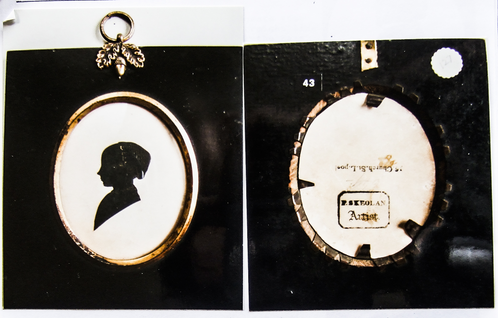Skeolan, Peter (SCC Newsletter November 1995)
P. Skeolan
Minor Artist – attribution problems.
 Suprisingly this Artist is represented in the Andrew's Collection at Stoner House. I have photographed the silhouette above together with it's backing stencil. Mrs. McKechnie did not know of the exsistence of the Andrew's Collection unfortunately before publishing her Book. I have also recently acquired a silhouette by him in a 'job lot' at an auction - I have illustrated this with it's stencil over the page. I apologise for the quality of this photograph but it still gives an adequate 'idea' of the silhouette.
Suprisingly this Artist is represented in the Andrew's Collection at Stoner House. I have photographed the silhouette above together with it's backing stencil. Mrs. McKechnie did not know of the exsistence of the Andrew's Collection unfortunately before publishing her Book. I have also recently acquired a silhouette by him in a 'job lot' at an auction - I have illustrated this with it's stencil over the page. I apologise for the quality of this photograph but it still gives an adequate 'idea' of the silhouette.
Mrs. McKechnie has an entry on Mr. Skeolan on page 272 of her Book. Mrs. Jackson also lists him in her Dictionary. He is known to have worked over a period of about twenty years and to have visited Halifax and Manchester for this purpose. Mrs. McKechnie states "that there is a paucity of his work" which seems rather strange. I thought it might be worth speculating on this, as it might well have implications for other artists of the period and also explain some of the problems of attribution that we have when we see silhouettes of the 1830's and 40's.
Mr. Skeolan would appear to present some of the 'classic' problems of many artists of the period - firstly his work was not of a high quality or especially skilled from my two examples at least; secondly there would also appear to be little of distinction in his style of work that would easily identify his work from others: thirdly he seems to have employed more than one artist (see Mrs. McKechnie) in his Gallery, which inevitably blurs the problems of attribution even more!
Stencils & labels. From the Andrew's silhouette and mine he was clearly in the habit of using a stencil. The Andrew's stencil has an address in Liverpool added but mine has no address at all. It is unlikely that a stencil would get completely rubbed off - so a very small identifiable bit of the stencil would be sufficent for attribution. The silhouette illustrated by Mrs. McKechnie has a stick-on label (see illus. 590 & 591 on page 342)
P. SKEOLAN. con’t.
 - whether it has a stencil on the back also we do not know. As we all know labels can easily be removed! The Liverpool address adds some new information to Mr. Skeolan's travels.
- whether it has a stencil on the back also we do not know. As we all know labels can easily be removed! The Liverpool address adds some new information to Mr. Skeolan's travels.
Bust-line termination. Mrs. McKechnie suggests that his bust-line termination was almost a straight line dipping to the front. Clearly this is not the case with the Andrew's girl and mine has a small dip at the back of the bust-line. So it seems that bust-line termination is not likely to be very helpful.
His Style. The gold highlighting on both is rather cursory and ‘thin’. The man’s shirt collar and front is ‘produced by cutting away the black paper. The gold is used to highlight edges of the collar, bow-tie, ear and details of the girls bonnet. No gum Arabic appears to be used. My man is mounted on standard card and is of ‘normal’ size. There would appear to be little here to help with attribution. Mr. Skeolan did full-length silhouettes, but I have not seen any of these. He also advertised as a miniature painter so hopefully he had some painting skills. Mrs. D. Foskett does not list him in her “Dictionary and Guide”
 I have illustrated below a painting in the Andrew’s Collection, which I think provides a little bit of silhouette history. It is presumably a painting of Mr. Skeolan painting his own sign, wheter it was painted by him we do not know. The board being painted states:- “Mr. Skeolan’s Miniature and Profile Gallery Established.” It is set in a bird’s eye maple-wood frame size 35.2cm’s rectangular. From the painting it looks as if his left hand could be ‘missing’ but perhaps it is ‘tucked away’ as the painter found it difficult to paint hands! I leave you to speculate.
I have illustrated below a painting in the Andrew’s Collection, which I think provides a little bit of silhouette history. It is presumably a painting of Mr. Skeolan painting his own sign, wheter it was painted by him we do not know. The board being painted states:- “Mr. Skeolan’s Miniature and Profile Gallery Established.” It is set in a bird’s eye maple-wood frame size 35.2cm’s rectangular. From the painting it looks as if his left hand could be ‘missing’ but perhaps it is ‘tucked away’ as the painter found it difficult to paint hands! I leave you to speculate.
Conclusions. His work will be difficult to identify. It will be variable in quality. We know he worked in Halifax, Manchester & Liverpool - so if the sitter comes from these areas bear Mr. Skeolan in mind. If a likely work has the backing covered it is worth 'getting-in' to see if there is a stencil on the back.
I would be glad to hear from any members who have an attributed example of his work.



